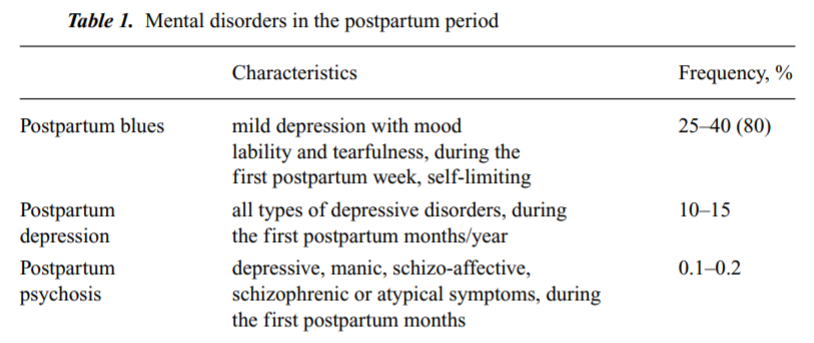Peripartum mood disturbances classification
 From Wikidoc - Reading time: 3 min
From Wikidoc - Reading time: 3 min
|
Peripartum mood disturbances Microchapters |
|
Differentiating Peripartum mood disturbances from other Diseases |
|---|
|
Diagnosis |
|
Treatment |
|
Case Studies |
|
Peripartum mood disturbances classification On the Web |
|
American Roentgen Ray Society Images of Peripartum mood disturbances classification |
|
Risk calculators and risk factors for Peripartum mood disturbances classification |
Editor-In-Chief: C. Michael Gibson, M.S., M.D. [1]; Associate Editor(s)-in-Chief: Sunita Kumawat, M.B.B.S[2]
Overview[edit | edit source]
During pregnancy and the postpartum period, many women feel a wide range of overwhelming emotions such as anticipation, happiness, excitement, confusion, pleasure, satisfaction, as well as worry, frustration, or sadness/guilt. They are more prone to mental problems during the postpartum period. Maternity blues, puerperal psychosis, and postnatal depression are the three most common postpartum mental illnesses. The spectrum of postpartum illnesses is broad. It encompasses a wide spectrum of feelings, ranging from mild agitation, irritability, and weepiness to severe agitation, delusions, disorientation, and delirium. On one end of spectrum lies postpartum blues, which is most common and remits on its own, while on the other end lies postpartum psychosis which in severe form is a medical emergency and needs urgent hospitalisation, postpartum depression is moderately common.
Classification[edit | edit source]
During the first week after delivery, about 25–40 percent of mothers experience mood lability and mild depression known as postpartum blues or postpartum dysphoria, about 10–15 percent suffer from a depressive disorder, and one or two out of every thousand women experience psychosis during the infant's first year. Traditionally, these conditions were referred to as "postpartum illnesses."

Peripartum mood disturbances may be classified according to Diagnostic and Statistical Manual of Mental Disorders, fifth edition (DSM-V) into 3 subtypes:[1][2]
During the postpartum period there is also increased susceptibility to anxiety disorders such as obsessive-compulsive disorder and panic disorder.
References[edit | edit source]
- ↑ Rai S, Pathak A, Sharma I (July 2015). "Postpartum psychiatric disorders: Early diagnosis and management". Indian J Psychiatry. 57 (Suppl 2): S216–21. doi:10.4103/0019-5545.161481. PMC 4539865. PMID 26330638.
 KSF
KSF